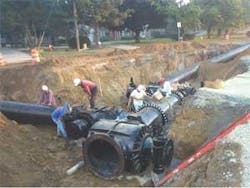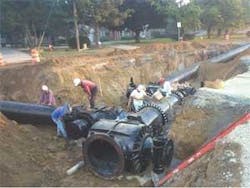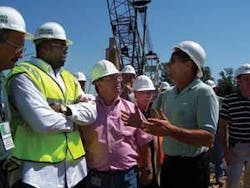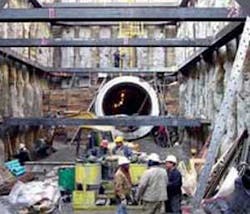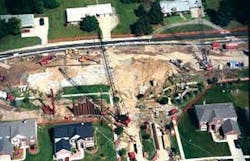Leadership Tested in Detroit Sewer Main Collapse
By George Ellenwood
When the Detroit Water & Sewerage Department’s Macomb Interceptor Sewer Main collapsed, public safety was critical to effective emergency response.
Crisis management skills can be taught at seminars and outlined in emergency operations manuals. But implementing those skills in the real world can be almost as difficult as resolving the situation itself. How will you manage the people involved? How do you deal with public health and safety issues? How do you protect your agency’s image with the media? How do you find the equipment you need – in the middle of the night? Whether your service area is large or small, urban or rural, serves hundreds or millions of customers – responses to those questions will be critical.
Victor Mercado, former director of the Detroit Water & Sewerage Department (DWSD), in Detroit, Michigan, USA, and current chief executive officer for the South Martin Regional Utility in Hobe Sound, Florida, near West Palm Beach, is well versed in this decision making. He once had to close part of a major U.S. metropolitan subway system after a massive water main break. He has seen damage to a water aqueduct shut down an entire highway system. He has watched a street disappear – curb to curb – following a water main break. And he was forced to condemn buildings, on the spot, for fear of collapse.
In 2004, he got the call that led to one of the biggest events yet – the collapse of an 11-foot diameter sewer main that carried up to 70 million gallons a day of wastewater from 363,000 residents. Mercado’s experience with large-scale emergencies would benefit southeastern Michigan that day. That crisis culminated in a fine-tuned list of the immediate action steps and approaches that all utilities can employ to ensure coordination and, ultimately, successful responses to crises. Mercado shares his insights and comments on crisis management.
Face to Face with Emergency
In the Detroit event, what was thought to be a minor water main break turned out to be collapse of an 11-foot diameter sewer main 60 feet below the surface of the ground. The line, known as the Macomb Interceptor, was the sole vehicle to transport wastewater from nine municipalities to the DWSD wastewater treatment facility. Pavement was giving way, some of the 250 nearby homes were shifting and a heavily traveled nearby thoroughfare was impassable. Other underground utilities – phone, electric and gas – were breaking or at risk. The potential ramifications were serious and dangerous.
Strategy Under Pressure
According to Mercado, understanding the common characteristics of emergencies and being prepared to address them can often mean the difference between response success or failure and can have lasting impacts on the reputation and credibility of the utility. The larger the event, the more critical are first response and immediate follow-up actions. Lessons learned include:
1. Get to the scene – Management from afar is unacceptable. Placing the highest decision-makers at the scene is a must and avoids losing valuable time.
2. Assess the situation and establish priorities – “Everything can seem like a top priority during large-scale events. But reality says you must deal with one thing at a time.” DWSD priorities were to:
- Ensure the immediate safety of citizens and workers.
- Protect public health. In the DWSD event, containing raw wastewater overrode service restoration in the first phase of the emergency response.
- Keep the system flowing – no matter what. Responders knew that bypass pumps and pipes would be needed immediately to support the interceptor.
3. Take charge – “Emergency response is not a democratic process. In any construction site, if you don’t have the entity responsible for the infrastructure taking charge, you’ll have chaos.”
4. Claim your turf – Security of the job site is paramount for many important reasons. Residents, officials or the media can stray or purposely enter the work site at any time. “As soon as someone unauthorized enters your job site, you lose control. We had only one injury in this entire emergency – a cut finger, because we maintained control and boundaries.”
5. Coordinate the response – Balancing the need to be in charge with the need to work with other affected agencies and interests is a challenge common to all emergencies. Cooperation is key and yet legal and public health responsibilities may ultimately reside with the utility.
“We were fortunate to work with great people from the city of Sterling Heights. Their cooperation was exceptional. By the time we arrived on site, they had established an Emergency Operations Center to provide centralized information sharing and decision making. This was critical, given the number of entities and agencies involved in the response.”
6. Know what you need and how to get it – “Mobilizing massive equipment and personnel takes time. You’ve got to have a pool of good resources (contractors, equipment vendors, experts) established in advance.”
7. Manage your people – “When you have multiple contractors and more than 100 people working to resolve an emergency, coordination and cooperation are essential, but sometimes hard to come by. You can’t manage an emergency by committee, but you can, and should, have input at all times.”
8. Meet frequently – Every contractor and entity involved was required to send a representative to daily meetings to discuss the previous day’s work and the current day’s plan. The group included municipal representatives, road commission and public works staff, health department representatives, public affairs staff, and state agencies. Issues were discussed and resolved in the meetings.
9. Make decisions – “You must make decisions. And you can’t belabor those decisions – you don’t have time. If you don’t move fast, you’ll cause delays that can jeopardize the safety of community or the integrity of the infrastructure and materials.”
10. Demand success – “At DWSD we had a very good resource pool, but there are no second chances in an event like this. You must demand performance or move to someone else who can do the job better.”
11. Be realistic – Agencies sometimes have to deliver bad news. The Macomb Interceptor involved a possibility of losing some homes. Residents near the interceptor repair site were told the truth about their homes and prepared for what might happen.
Candid Communication
A utility can more successfully manage its progress and reputation during and after an emergency if consistent, organized and candid communication is part of the response effort.
“We needed to demonstrate early on that the top people were involved, in charge and taking action,” says Mercado. “Communication – good or bad – will be a part of your response efforts whether you want it or not, so you should be prepared.”
1. Expect very high media interest – As long as the emergency or crisis continues to have a high visual appeal or an element of controversy, expect a flurry of media attention to continue unabated.
2. Designate a key spokesperson – Good work in an emergency can be lost or ignored if the designated spokesperson does a poor job. A misstatement by an untrained spokesperson or inconsistencies among multiple spokespersons can quickly generate controversy or distract from the facts.
3. Cultivate calm – Based on years of experience, Mercado knew there was no value in dodging the important issues. “People are understandably concerned and even scared. We had to reduce their fears and concerns by sharing the facts. “
4. Anticipate negative public reaction – “Imagine that you have six families evacuated from their homes unsure if they will ever see their belongings again. Of course they’ll be upset. Facing that in a direct but sensitive way was essential.”
5. Keep local leaders informed – In any crisis, it’s important to keep local leaders and elected officials informed of the situation. It’s best that they hear any critical news up front from the organization in charge, before seeing or hearing it on the news.
6. Pay attention to the rumor mill – While emergency responders are focused on getting the job done, rumors in the public can run rampant. It’s important to have someone in charge of monitoring information and clarifying the facts. DWSD’s quick response to correct rumors helped maintain calm, and preserve credibility.
Emergency vs. Repair
It’s important to know when an “emergency” is no longer an emergency. While it may seem straightforward, the decision on when an emergency response technically becomes a construction project is complicated and has far-reaching implications.
When the decision is made to end the emergency designation, personnel and agencies involved need to move from “crisis” mode” into “normal” construction repair mode. The Emergency Operations Center will close, media attention will diminish to some degree, and the headquarters for communications and project management will relocate to an office.
“This doesn’t mean you stop communicating and pressing forward,” Mercado advises. “You’re just no longer in emergency mode.” In the Macomb Interceptor project, the emergency mode ended when a permanent sewer bypass was in place. This ensured the community would have wastewater service if the interceptor failed because all the necessary redundant equipment was in place.
Evaluation
Learning from experience was the most important thing DWSD officials could do at the conclusion of the emergency. DWSD and others met repeatedly to review actions taken and make improvements where needed. Thanks to those efforts and construction that was ahead of schedule, a solid system and community partnership continues to bring quality sewer services to southeast Michigan.
Author’s Note:
George Ellenwood is assistant public affairs director at the Detroit Water & Sewerage Department. He serves on the Public Affairs Council of the American Water Works Association (AWWA) and Research Advisory Council of the AWWA Research Foundation. He also serves on the Community Awareness Committee of the Michigan Section of AWWA and is a member of the Public Relations Society of America and Water Environment Federation. Contact: www.dwsd.org
null
